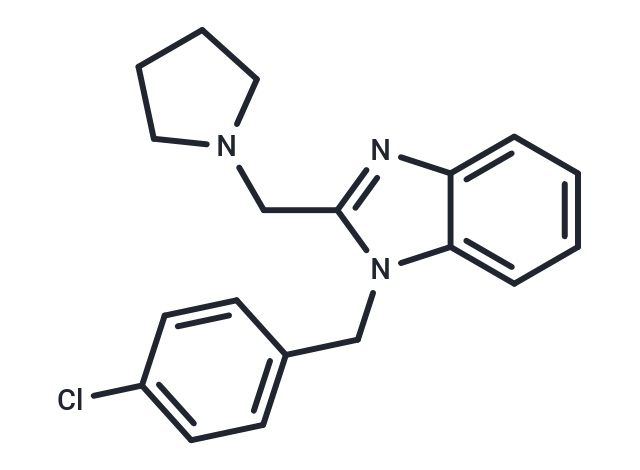Shopping Cart
- Remove All

Your shopping cart is currently empty


| Pack Size | Price | Availability | Quantity |
|---|---|---|---|
| 1 mg | $37 | In Stock | |
| 5 mg | $79 | In Stock | |
| 10 mg | $108 | In Stock | |
| 25 mg | $163 | In Stock | |
| 50 mg | $285 | In Stock | |
| 100 mg | $512 | In Stock | |
| 500 mg | $1,080 | In Stock | |
| 1 mL x 10 mM (in DMSO) | $89 | In Stock |
| Description | Clemizole is an H1 histamine receptor antagonist, can inhibit NS4B's RNA binding and hepatitis C virus (HCV) replication. |
| In vitro | Clemizole hydrochloride is found to inhibit HCV RNA replication in cell culture that is mediated by its suppression of NS4B's RNA binding, with little toxicity for the host cell. The EC50 of Clemizole on the W55R mutant J6/JFH RNA is ~18 μM (2.25 times the EC50 of the wild-type RNA)[1]. Clemizole is a novel inhibitor of TRPC5 channels. Clemizole efficiently blocks TRPC5 currents and Ca2+ entry in the low micromolar range (IC50=1.0-1.3 μM). Clemizole exhibits a six-fold selectivity for TRPC5 over TRPC4β (IC50=6.4 μM), the closest structural relative of TRPC5, and an almost 10-fold selectivity over TRPC3 (IC50=9.1 μM) and TRPC6 (IC50=11.3 μM). Clemizole hydrochloride as a novel blocker of TRPC5 with a half-maximal inhibitory concentration of 1.1 μM. The concentration-response curves confirmed a concentration-dependent block of TRPC5 by Clemizole and revealed an apparent IC50 of 1.1±0.04 μM[2]. |
| In vivo | Clemizole hydrochloride demonstrates a significantly short plasma half-life, recorded at 0.15 hours, in C57BL/6J mice. It is swiftly metabolized into a glucuronide (M14) and a dealkylated metabolite (M12), along with several minor metabolites[3]. |
| Cell Research | Clemizole hydrochloride is dissolved in DMSO and stored, and then diluted with appropriate media before use[1]. Huh7.5 cells are maintained in DMEM supplemented with 1% L-glutamine, 1% penicillin, 1% streptomycin, 1× nonessential amino acids and 10% FBS. Cell lines are passaged twice weekly after treatment with 0.05% trypsin-0.02% EDTA and seeding at a dilution of 1:5. Subconfluent Huh7.5 cells are trypsinized and collected by centrifugation at 700 g for 5 min. The cells are then washed three times in ice-cold RNase-free PBS and resuspended at 1.5×107 cells/mL in PBS. Wild-type or mutant FL-J6/JFH-5′C19Rluc2AUbi RNA for electroporation is generated by transcription of XbaI linearized DNA templates using the T7 MEGAscript kit, followed by purification (RNA transcription and fluorescent labeling). We mixed 5 μg of RNA with 400 μL of washed Huh7.5 cells in a 2-mm-gap cuvette (BTX) and immediately pulsed (0.82 kV, five 99 μs pulses) with a BTX-830 electroporator. After a 10 min recovery at 25°C, pulsed cells are diluted into 10 mL of prewarmed growth medium. Cells from several electroporations are pooled to a common stock and seeded in 6-well plates (5×105 cells per well). After 24 h, medium is replaced and cells are grown in the presence of serial dilutions of the various inhibitory compounds (e.g., Clemizole hydrochloride) identified in the screen. Seventeen commercially available compounds, out of the 18 identified, are analyzed. Untreated cells are used as a negative control for water-soluble compounds. For compounds (e.g., Clemizole hydrochloride) solubilized in DMSO, untreated cells are grown in the presence of corresponding concentrations of the solvent as a negative control. Medium is changed daily. After 72 h of treatment cells are subjected to an Alamar Blue-based viability assay and luciferase assay. After 72 h of treatment cells are incubated for 3 h at 37°C in the presence of 10% Alamar Blue reagent.Plates are then scanned and fluorescence is detected by using FLEXstation II 384. Depending on the inhibitory compound's solvent (e.g., Clemizole hydrochloride), water or DMSO, signal is normalized relatively to untreated samples or samples grown in the presence of DMSO, respectively[1]. |
| Molecular Weight | 325.84 |
| Formula | C19H20ClN3 |
| Cas No. | 442-52-4 |
| Storage | Powder: -20°C for 3 years | In solvent: -80°C for 1 year | ||||||||||||||||||||||||||||||
| Solubility Information | DMSO: 22.5 mg/mL (69.05 mM) | ||||||||||||||||||||||||||||||
Solution Preparation Table | |||||||||||||||||||||||||||||||
DMSO
| |||||||||||||||||||||||||||||||

Copyright © 2015-2024 TargetMol Chemicals Inc. All Rights Reserved.